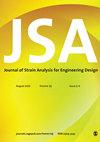Subsurface stresses in an elliptical Hertzian contact
IF 1.4
4区 工程技术
Q3 ENGINEERING, MECHANICAL
Journal of Strain Analysis for Engineering Design
Pub Date : 2021-12-08
DOI:10.1177/03093247211060288
引用次数: 3
Abstract
The traditional solution for the stresses below an elliptical Hertzian contact expresses the results in terms of incomplete Legendre elliptic integrals, so are necessarily based on the length of the semi-major axis a and the axis ratio k. The result is to produce completely different equations for the stresses in the x and y directions; and although these equations are now well-known, their derivation from the fundamental, symmetric, integrals is far from simple. When instead Carlson elliptic integrals are used, they immediately match the fundamental integrals, allowing the equations for the stresses to treat the two semi-axes equally, and so providing a single equation where two were needed before. The numerical evaluation of the Carlson integrals is simple and rapid, so the result is that more convenient answers are obtained more conveniently. A bonus is that the temptation to record the depth of the critical stresses as a fraction of the length of the semi-major axis is removed. Thomas and Hoersch’s method of finding all the stresses along the axis of symmetry has been extended to determine the full set of stresses in a principal plane. The stress patterns are displayed, and a comparison between the answers for the planes of the major and minor semiaxes is made. The results are unchanged from those found from equations given by Sackfield and Hills, but not previously evaluated. The present equations are simpler, not only in the simpler elliptic integrals, but also for the “tail” of elementary functions.椭圆赫兹接触中的地下应力
椭圆赫兹接触下应力的传统解用不完全勒让德椭圆积分来表示结果,因此必须基于半长轴长度a和轴比k。其结果是产生x和y方向上完全不同的应力方程;虽然这些方程现在已经很有名了,但是从基本的,对称的积分中推导出这些方程并不简单。当使用卡尔森椭圆积分时,它们立即与基本积分相匹配,允许应力方程平等地对待两个半轴,从而提供了一个以前需要两个方程的方程。卡尔森积分的数值计算简单、快速,因此结果是更方便地得到更方便的答案。一个好处是,将临界应力的深度记录为半长轴长度的一部分的诱惑被消除了。Thomas和Hoersch找到沿对称轴的所有应力的方法已经扩展到确定主平面上的全部应力。显示了应力模式,并对主半轴平面和小半轴平面的答案进行了比较。这些结果与萨克菲尔德和希尔斯给出的方程的结果没有变化,但之前没有评估过。不仅在较简单的椭圆积分上,而且在初等函数的“尾巴”上,本方程都较简单。
本文章由计算机程序翻译,如有差异,请以英文原文为准。
求助全文
约1分钟内获得全文
求助全文
来源期刊

Journal of Strain Analysis for Engineering Design
工程技术-材料科学:表征与测试
CiteScore
3.50
自引率
6.20%
发文量
25
审稿时长
>12 weeks
期刊介绍:
The Journal of Strain Analysis for Engineering Design provides a forum for work relating to the measurement and analysis of strain that is appropriate to engineering design and practice.
"Since launching in 1965, The Journal of Strain Analysis has been a collegiate effort, dedicated to providing exemplary service to our authors. We welcome contributions related to analytical, experimental, and numerical techniques for the analysis and/or measurement of stress and/or strain, or studies of relevant material properties and failure modes. Our international Editorial Board contains experts in all of these fields and is keen to encourage papers on novel techniques and innovative applications." Professor Eann Patterson - University of Liverpool, UK
This journal is a member of the Committee on Publication Ethics (COPE).
 求助内容:
求助内容: 应助结果提醒方式:
应助结果提醒方式:


